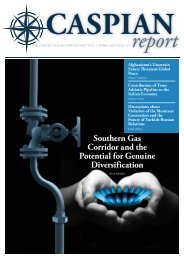Create successful ePaper yourself
Turn your PDF publications into a flip-book with our unique Google optimized e-Paper software.
alised energy market: transparent,<br />
competitive, interconnected, liquid,<br />
and flexible.<br />
2. THE NEW STATUS OF CRIMEA<br />
UNDER INTERNATIONAL LAW<br />
Right after the political change in<br />
Kiev, at the end of February <strong>2014</strong>, unidentified<br />
military forces, supported<br />
by segments of the local population,<br />
took control of the political and administrative<br />
centres and critical infrastructure<br />
elements in Crimea. On<br />
February 28, the Supreme Council of<br />
the Autonomous Republic of Crimea<br />
voted for divestiture of the regional<br />
government and to hold a referendum<br />
on the republic’s extended autonomy.<br />
On March 6, the Supreme<br />
Council and the local council of Sevastopol<br />
made public the intention<br />
to declare Crimea’s independence<br />
from Ukraine as united national entity,<br />
its potential integration in the<br />
Russian Federation, and the plan for<br />
a public referendum in this respect.<br />
On March 11, the Supreme Council<br />
declared the Autonomous Republic<br />
of Crimea’s independence from<br />
Ukraine. On March 15, Russia exercised<br />
its veto right with regard to a<br />
draft resolution of the UN Security<br />
ACCORDING TO THE FOREIGN POLICY CONCEPT<br />
OF THE RUSSIAN FEDERATION (20<strong>08</strong>), THE CEE<br />
REGION IS “THE AREA WITH THE BROADEST<br />
GEOPOLITICAL MEANING FOR THE RUSSIAN<br />
FEDERATION.”<br />
Council declaring the referendum invalid.<br />
On the same day, Kiev decided<br />
on the dissolution of the Supreme<br />
Council of Crimea (regional parliament).<br />
On March 16, a referendum<br />
was organized in Crimea in which<br />
97% of the population allegedly voted<br />
for independence and accession<br />
to the Russian Federation. On March<br />
17, the parliament of Crimea declared<br />
independence and requested<br />
annexation to Russia. Thus, Russia<br />
“gained” two new entities, the Crimea<br />
Federal District and the federal city<br />
of Sevastopol. On March 17, Vladimir<br />
Putin issued a decree recognising<br />
Crimea as a sovereign and independent<br />
state. The Crimea annexation/<br />
unification treaty was signed the<br />
next day. On March 21, Putin signed<br />
the laws formally acknowledging<br />
Crimea and Sevastopol as part of the<br />
Russian Federation. The UN General<br />
Assembly issued a non-binding<br />
73<br />
CASPIAN REPORT, FALL <strong>2014</strong><br />
Russian Energy<br />
Minister Alexander<br />
Novak, EU Energy<br />
Commissioner<br />
Gunther Oettinger<br />
and Ukraine’s<br />
Energy and Coal<br />
Industry Minister<br />
Yuri Prodan signing<br />
an agreement.










